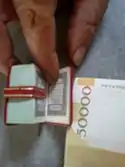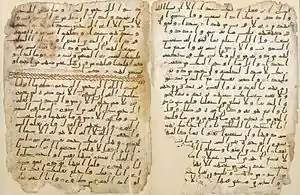Miniature Quran
Thumbnail Quran (Persian: قرآن بندانگشتی) or Miniature Quran are tiny-written Qurans having 2 types: Modern and Antique. Newer versions are produced in China, United Arab Emirates and Iran. But the antique versions can have almost 2 cm length, 1.5 cm width and 1 cm thickness. Some of them in hexagon or octagon shapes and with a metal box and a gilded leather wrapper.[1] Very antique versions have fragile papers may be foxed in contact with air. Many versions date back to the Ottoman Empire era in Turkey, in Egypt dating back possibly to the Khedivate of Egypt, and production of them in England during WWI.[2] Some are also written in different translations, such as Persian.


History
National Library of Scotland says the producing of the traditional manuscripts of mini Qurans is an old rite but the printing ones such as Egyptian is relating to emerging Photolithography in the 19th century. This library estimates the Istanbul and Delhi printing versions to 1892 and 1899, but the vast spreading of mini books is owed to David Bryce.[2] All printed versions had a metal box and a tiny magnifier giving to the Muslim soldiers fighting for Britain during the World War I.[2] In a lasting work by Thomas Edward Lawrence he says : "Auda told me later in strict confidence that he had bought a miniature Qur'an for one hundred and twenty pounds, thirteen years before, and had not since been wounded … The book was one of the little Glasgow reproductions, costing eighteen pence in England, but the Arabs were too afraid of Auda's deadliness to laugh at his superstition … or to explain to him his bad bargain."[2][3]
The pages of these books has an empty margin sometimes with east-art drawings and magnifier is needed to read the texts. Some of Iranian soldiers had them during the Iran–Iraq War.
In 2012 Press TV (IRIB) introduced an antique instance in Ukraine [4][5] and some other cases in Iran, IRIB Hamedan in 2011 introduced another.[6][7] Some of them have been sold on eBay too.[8]
In 2012 The Hindu newspaper quoting from Salar Jung Museum talked about an oldest version mini Quran (partly verses) in 3x2cm dimensions with 31 leaves of Parchment in Kufic handwriting belongs to the 9th century.[9]
See also
References
- "1872 Miniature holy Koran published in 1872 and "found" in the ruins of the Palace in Zanzibar after the British bombardment in 1896".
- "A miniature Qur'an". National Library of Scotland. Archived from the original on 28 Feb 2016.
- T. E. Lawrence. "chapter 57". Seven Pillars of Wisdom. book 4.CS1 maint: uses authors parameter (link)
- "Ukrainian collector owns antique mini Qur'an". Press TV. April 2012.
- "Ukrainian collector owns antique mini Qur'an". YouTube. Press TV.
- "قران بند انگشتی". Islamic Republic of Iran Broadcasting Hamedan channel. Oct 2011. Archived from the original on 2 Oct 2013.
Note:The Parthian mentioned there is not true
- "قرآن برندانگشتی". negahmedia. IRIB Hamedan. Oct 2011.
- http://www.ebay.ie/itm/1960s-RARE-HANS-STEINBRENER-MINIATURE-KORAN-QURAN-CORAN-ANTIQUE-ISLAMIC-BOOK-/191772475541?hash=item2ca687c095:g:flgAAOSw3xJVX4pT
- "Plans for an Islamic art gallery in Salarjung Museum". The Hindu. Archived from the original on 28 Nov 2013.


